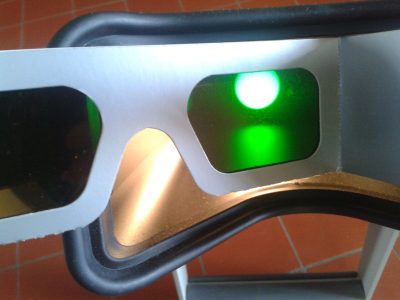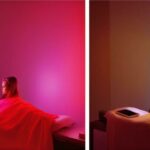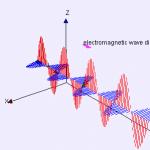Last Updated on 2 years by Francis
Contents
What is Syntonic Light Therapy ?
What is Syntonic
It is a non-invasive treatment option.
This kind of treatment begins with wearing colored filtered googles for at least 10 minutes. The color filter of the google depends on the condition of the vision problem.
Working Principle
Applying certain wavelengths with each wavelength corresponding to different light such as : blue, red, yellow with 600 nm is applied to the eye with googles.
When the
light enters the eye, not only it creates images as one perceives it but it travels to the brain and stimulate it by restoring the body’s nervous system.Orange, yellow and red stimulate the sympathetic nervous system ( SNS)
Blue, violet stimulate the parasympathetic nervous system (PNS)
SNS controls the fight or flight response and pupils dilates.
PNS controls homeostasis constricting the pupils.
For example : Red and Orange treats lazy eyes while green and yellow treats eyes that are inward.
Blue wavelength
light will help doing work and focus problems with the eyes.The
light waves are emitted from a device known as’reflectedlight transceivers’ which are typically used for various different medical treatments and therapies to induce relaxation and stress reduction.
Syntonic
By using the
Studies on Syntronic
These studies have shown that Syntonic
Some of the different types of Syntonic
Syntonics light therapy at home
If you are looking for ways to treat your vision problems without having to go to a doctor, you should consider using Syntonics light therapy at home. This therapy has been clinically used for over 90 years and has been proven to be effective for people with vision problems. This treatment uses light frequencies to enhance visual attention and improve your understanding of what you see. It is also safe and can be done at home. In addition, it can help balance your body systems.
This therapy is a branch of ocular science based on the study of Dr. Harry Riley Spitler. It involves exposure to specific wavelengths of light that stimulate specific biochemistry in the brain. This stimulates the release of neurotransmitters, which help the brain grow in new directions. It is a noninvasive method for treating a variety of vision problems and can also be used as an adjunct therapy with other therapies.
Colored light
For decades, doctors have used syntonics to treat conditions, from jaundice in newborns to seasonal affective disorder. This method uses colored light to stimulate biochemistry within the brain, including the production of Neurotransmitters. These chemicals are involved in the body’s processes, which enable growth in new directions. Syntonics was developed by Dr. Harry Riley Spitler, an American scientist. Today, there are more than 5,000 articles in the medical literature about this therapy.
The biochemical centers of the brain influence all of the body’s functions, including vision. Syntonic light therapy stimulates these biochemical centers to restore the balance in the autonomic nervous system, which is directly related to the source of visual dysfunction. Patients experiencing these problems may experience a range of benefits, including reducing the frequency of their daily activities and reduced stress levels. Syntonic light therapy uses several different colors in the visible spectrum.
Depending on the condition, Syntonics is the treatment of choice for the affected person. During treatment, the patient must view a circle of colored light for approximately 20 minutes. This can greatly improve symptoms and aid in improving visual performance. The wavelength of light used in the therapy will depend on the visual diagnosis, but the frequency of the light will most likely be the same for all patients. For example, patients with Esotropia need red light, while those with Exotropia need blue light.
Treat seasonal affective disorder
One of the simplest and most effective ways to treat seasonal affective disorder is through the use of syntonic light therapy. This type of therapy involves exposing the patient to certain wavelengths of light during a specified amount of time. The light therapy must be done consistently throughout the winter months in order to have the desired effect. It can help with the symptoms of seasonal affective disorder, including depressive episodes.
The process of using syntonic light therapy is based on the principle that certain frequencies of light can help restore the balance between the sympathetic and parasympathetic nervous systems. These two systems function in fast and slow responses and each frequency of light affects one of them differently. The syntonic light therapy used in winter is safe for everyone, and it is effective for a variety of conditions. However, patients should always speak with a doctor before beginning a treatment program.
Studies have shown that bright green light can improve symptoms of seasonal affective disorder and other mood disorders. Despite the benefits of light therapy, it is important to note that this treatment is still in its early stages and requires more research to confirm its effectiveness. However, it is an effective treatment for many seasonal depression patients. It is safe and effective, and can even be used alongside existing medications. It’s a great alternative for depression sufferers who are concerned about side effects.
Parasympathetic nervous systems
This form of light therapy can be used to treat a variety of conditions. It is especially helpful for patients suffering from chronic headaches, stress, learning disabilities, trauma, and concussions. It works by stimulating the visual system. The patient wears colored filter goggles that are placed over their eyes for the duration of the light therapy session. The color of the filter goggles is dependent on the visual problem the patient is experiencing.
The therapy is based on the fact that light stimulates the different actions within the cells. Light energy is rapidly diffused throughout the body and can reach 40% of the blood supply in just 20 minutes. The wavelength and color of the light are chosen based on the type of vision problem that the patient is experiencing, and the resulting imbalance. The light therapy can help the patient regain balance in his/her system and improve their symptoms.
This form of light therapy works by affecting the interaction between the eye and the brain. It also helps balance the sympathetic and parasympathetic nervous systems. The syntonic principle was developed by Dr. H. Riley Spitler, who referred to light as syntonic, which means “to bring into balance”. He published a clinical study in 1933, which found that 90.7% of the patients responding to the therapy showed a significant improvement.
Chronic headaches
Syntonic light therapy can relieve the symptoms of chronic headaches by stimulating the visual system. The specific frequencies of light that syntonics uses affect the brain’s parasympathetic and sympathetic nervous systems. They are responsible for quick responses and slower responses, respectively. Patients who undergo syntonic light therapy will find relief from eye strain, headaches, pain, inflammation, and overall stress. Syntonic light therapy is effective because it helps restore the balance between these two systems.
While this technique is not proven to be effective for chronic migraines, it is an attractive alternative to drug-based treatment for headaches. In addition to providing relief, syntonic light therapy can also improve the quality of life of sufferers. Researchers are currently investigating wearable devices for this purpose. One option involves wearing green light for several hours at a time. In addition to being comfortable, these devices emit green light, which can block blue light.
A patient undergoing syntonic light therapy has a better peripheral vision. The color of light used for syntonic therapy is chosen based on the patient’s pupil size and type of visual problem. During the first session, a 78-year-old woman with double vision was able to perform everyday tasks. Following a series of twelve 20-minute syntonic treatments, the woman was able to regain her balance and coherence.
Depth perception
While the benefits of using syntonic light therapy are widely recognized, you may wonder how this method can benefit your own vision. It uses a special light device with a white light source behind coloured absorption filters and a frosted collimating lens. This light then appears as a saturated colour glowing dot that can be steady or strobed. The light used in syntonic therapy is a specific wavelength that stimulates the brain and restores the nervous system to normal functioning.
Various scientific studies have shown that light therapy can improve visual functions. One such example is depth perception. Insufficient depth perception can cause dizziness and lingering head pain. Furthermore, a poor ability to focus may impair binocular and accommodative vision, which may lead to headaches and other eye conditions. Other effects of a brain injury can include decreased visual memory, speech, and organizational skills.
Photo syntonic light therapy
The benefits of photo syntonic light therapy can improve visual performance and symptoms of eye problems. It works by exposing the patient to a circle of colored light for at least 15 minutes. The color of light used varies depending on the patient’s visual diagnosis. Patients with esotropia, for instance, need red or blue light to improve their vision. Patients with exotropia need blue light.
Several studies have found that syntonic light therapy can help relieve conditions such as chronic headaches and learning disabilities. It can also reduce the effects of trauma, concussions, and stress. Syntonic light therapy has also been shown to improve the central nervous system and the endocrine system. Syntonic light therapy can also be effective for certain types of refractive surgery patients and the pediatric population.
Researchers began to study the effects of light on the body early in the twentieth century. This work was based on the principles of syntonics, a science that combines medical and optometric training. Researchers based photo syntonic light therapy on the work of Dr. Harry Riley Spitler, who studied phototherapy in 1909. Dr. Spitler’s research paved the way for a new field of science called syntonics.
Body functions
Many people use Syntonic Light Therapy for pain relief and relaxation, but there are also other benefits to this treatment. For example, it can alleviate stress, anxiety, and depression. In addition, it can help people who suffer from binocular visual problems. By increasing peripheral vision, Syntonics can improve overall performance. Moreover, a series of 20 syntonics sessions can help patients deal with eye strain, headaches, inflammation, and overall stress.
Throughout history, humans have been using light to help them deal with a range of disorders and ailments. In ancient Greece, Greeks built solarium cities in high mountains where the rays of sunlight were harnessed for healing. The treatment of smallpox was also credited to the power of sunlight, and it is believed to improve mental and physical performance. Later in the nineteenth century, medical practitioners began using light to heal patients. In the 1920s, H. Riley Spitler studied how the human eye responded to various frequencies of light. He also developed the concept of “syntonics”, which means a balanced nervous system.
One of the most important ways in which Syntonic Light Therapy works is by reestablishing the balance of the nervous system, which is critical for all body functions. It works by stimulating the different regulatory centers of the brain through specific color frequencies. In contrast to white light therapy, Syntonic Light Therapy uses specific wavelengths of light to stimulate the brain’s nervous system. When syntonic light is applied to the eyes, it stimulates the same regulatory centers that produce the body’s natural hormones.
Syntonic Light Therapy For Strabismus, Cross Eye Contractions And Other Problems
Syntonic
A recent study showed that, in laboratory tests, syntonic light therapy produced no reaction in one group of test subjects and significantly reduced eye strain in another.
Test subjects were given a visual challenge, either with a list or a picture, or with their own images or letters, and none of the groups showed any significant increase in performance on the visual task.
In this study, the syntonic
light therapy was shown to improve performance by lessening eye strain during the visual challenge.The testing was performed using the classic test of eye movement, where a bright
light is paired with a specific letter. If the eye does not move towards or away from the stimulus, then the eye is said to be strain free.The Syntonic light system provided the required visual stimulation without causing eye movement or discomfort.
Syntonic light treatment as applied in this study provides much needed relief for the millions of people suffering from strabismus, crossed eyes or other vision impairments caused by convergence insufficiency.
Clinical trials have shown that the benefits are not limited to the visual system, but extend to the central nervous system, the endocrine system, the cardiovascular system and the gastrointestinal tract.
This new technology is being used for rehabilitation programs in rehabilitation clinics, senior centers, acute care hospitals, home health agencies and schools. It is also recommended for use in the pediatric population and certain patients with refractive surgeries.
No significant side effects have been reported and the safety of the treatment has been established through repeated placebo-controlled studies.
Syntonic Light Therapy For Acute Pathology
Syntonic
It has been found that this form of treatment can improve symptoms of chronic darkness and poor vision especially in aged patients and those suffering from retinal disease. The
Although some patients may not suffer from any visible symptoms after the initial period of
In such cases, further sessions might be necessary.
Some of the symptoms which might be treated during the
In order to treat such problems, the patient might be given artificial photocoagulation.
However, the results were found to be more effective when compared to the conventional treatments administered before the procedure.
Some of the common symptoms associated with
light therapy include decreased night vision, glare, eye soreness, itching, pain and dryness.It is important to note that such symptoms occur only under certain conditions. Such conditions include certain types of diseases including cataract and glaucoma.
What You Need to Know About Syntonic Light Therapy For Infertility
Syntonic
It is a non-invasive treatment that stimulates the body to produce both progesterone and estrogen, thereby enhancing reproductive functions.
The treatment consists of a four-step procedure which is supposed to produce greater hormonal balance, relax the reproductive organs, stimulate uterine contractions and increase estrogen and progesterone levels in the body.
There are some common experiences that women have reported after undergoing SLT.
The most common effect reported is an increased feeling of fullness.
However, it should be noted that fullness varies with each patient as some may feel a lighter feeling while others may feel a stronger form of cramping or discomfort.
Also, there is a change in bowel habits as some people claim that their bowel movements do not seem to go as smoothly as before and they experience involuntary contractions as well as bowel leakage. These are all reported side effects of Syntonic
Side Effects of Syntonic Light Therapy
If you are interested in trying Syntonic
First, let us begin by informing you of the benefits of this type of alternative treatment. Many people who have found success in treating their addictions with syntonic
Syntonic
This
One of the most common side effects, which is noticed within the first week of using Syntonic
Syntonic Light Therapy For Weight Loss
Syntonic
The idea behind this particular type of
As we know too well with the dangerous side effects of traditional medicine today, using synthetic methods instead is a great way to improve one’s health without causing as many problems as traditional medicine.
How Syntonic Light Therapy Helps Improve Quality of Sleep
When considering how to improve the quality of sleep, and thus improve your quality of life overall, one
Syntonic
Many people who experience chronic pain or depression can benefit from this type of treatment.
So what is syntonic
Syntonic
This type of
When the light reaches the choroid, the small intestine, the light emits waves that are beneficial to the patient’s digestive system.
As the waves reach the stomach and duodenum the pain associated with these symptoms is reduced, in some cases, altogether.
Syntonic Light Therapy – A Natural Alternative to Curing Your Pain
The use of synthetic
Syntonic
By blocking out blue
Studies have shown that people suffering from depression, chronic pain, migraines and other mood disorders respond quite well to these treatments.
Light
Our bodies slowly convert into a more relaxed state after exposure to natural sunlight for a certain period of time.
During this time, our bodies allow more energy to enter our cells, allowing the brain to operate at a much higher level.
During the darker hours of the day when natural sunlight is harder to find, our brains operate at a lower level because there is less chance for stimulation from the outside world.
Syntonic
What is Syntonic Light Therapy For ADHD and ADD?
Have you ever heard of syntonic
In many cases our eyes tend to get tired and we simply do not have enough visual attention to perform at our best.
As a result our performance suffers and we often find ourselves doing less well in school or having a poor result in sports.
The Benefits of Syntonic Light Therapy
Syntonic
SLT is based on the principle that eye injuries occur due to a loss of synchronization between the brain and the retina.
By restoring this order, visual acuity and contrast can be restored. It is an innovative method of treating eye disorders, such as macular degeneration and cataract, as well as conditions related to retinal detachment.
Syntonic
Light rays are emitted at different angles to achieve the desired effect, with greater intensity at the top of the visual field relative to the bottom.
As the
Improvement in visual acuity and contrast can result from as little as two to three treatments.
Most patients experience a significant benefit within the first month. However, patients must remember to visit the doctor regularly to prevent vision problems caused by medication.
In addition, it is important to note that results do not necessarily appear right away.
For some patients, results may only be evident after a number of months of regular treatments. However, patients who notice an improvement should continue regular treatments to achieve the best visual acuity and contrast.
What is Syntonic Light Therapy ?
Syntonic
It is used to treat ailments such as degenerative diseases, developmental disorders, cancer, chronic pain conditions, neurological disorders and eye disorders.
The main principle behind Syntonic
- In fact, it has been found that different levels of blue wavelength
light are capable of stimulating a patient’s immune system. - The basic principle behind Syntonic
Light Therapy is that exposure to certainlight stimulates the brain in much the same way as being exposed to a strong stimulus would - Another application of Syntonic
Light Therapy is in the field of visiontherapy , where it is used to treat people who have vision problems due to eye defects such as Macular Degeneration or Blindness. - Red, blue, and green high-energy blue wavelength light have the ability to enhance color vision in affected individuals and reduce the risks of developing poor eyesight.
How Syntonic Light Therapy Triggers the Biochemical Oxygenation of the Visual System of the Human Brain
Syntonic
This particular type of treatment uses an optical signal that is captured by a video camera placed at the eye’s point of focus and then be subjected to an alternating
It stimulates the brain’s biochemistry of determining the time and period of
The positive effects and the results of this treatment are permanent and depend on the patient’s vision ability to adjust to the alternating
However, this particular type of treatment may not be the best choice for those who suffer from certain visual impairments such as crossed eyes, strabismus (crossing or turning of the eyes), astigmatism, presbyopia, and presbyopia.
For these patients, it is best to undergo a Traditional treatment before trying SLT. The primary disadvantage of this treatment is that it only treats the visual impairment and does not treat the central nervous system.
Hence, while SLT helps restore normal visual performance, it may only do so to a certain extent.
Some individuals have noticed that their visual abilities have improved when they used Syntonic Phototherapy.
They report that the
This may be the reason why some individuals who have suffered from the devastating effects of stroke or head trauma will notice an immediate and positive improvement in their senses after the treatment sessions.
Because of the immediate changes that can be seen in the visual abilities of patients, this method of treating alzheimers and chronic pain can be considered effective.
How Syntonic Light Therapy Dentists Use Light To Bond Teeth
Syntonic
The practice is relatively new, and only a handful of dentists practice this style of care. These dentists work closely with their patients to ensure that they have white teeth, and a smile that sparkles with health and beauty.
It is important for patients to consult with their doctor before trying any type of treatment, since some forms of this
For this reason, it is important for people who are interested in these treatments to find a dentist who practices syntonic
Whether you want to remove stains or whiten your teeth, artificial
While syntonic
With a beautiful smile and a healthy set of teeth, you can get what you want from the people who will be working in your mouth.
Syntonic White Light Therapy – Winter Blues Cured
Researchers at Cambridge University have found that exposure to low levels of
Low levels of
Another study done in the UK involving the use of bright
Why Physicians Use Syntonic Blue Light Therapy To Treat Infants With Jaundice
What is Syntonic
Blue
In the case of treating infants, blue
Physicians who use this method to treat infants with jaundice do so with “patient specific” light that is tailored to the particular needs of the patient and the condition being treated.
Why Physicians Use Syntonic Blue
It’s not known exactly how blue
Because bilirubin is believed to be linked to the cause of jaundice in human babies, the use of blue
What Is Jaundice In Babies: Doctors and researchers are not sure what causes the condition of jaundice in infants but many believe it is caused by the same things that cause adult jaundice.
These factors include low birth weight, premature births and mothers who douche. Infants with jaundice will have an elevated bilirubin levels and may be treated with syntonic blue









